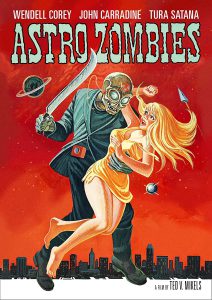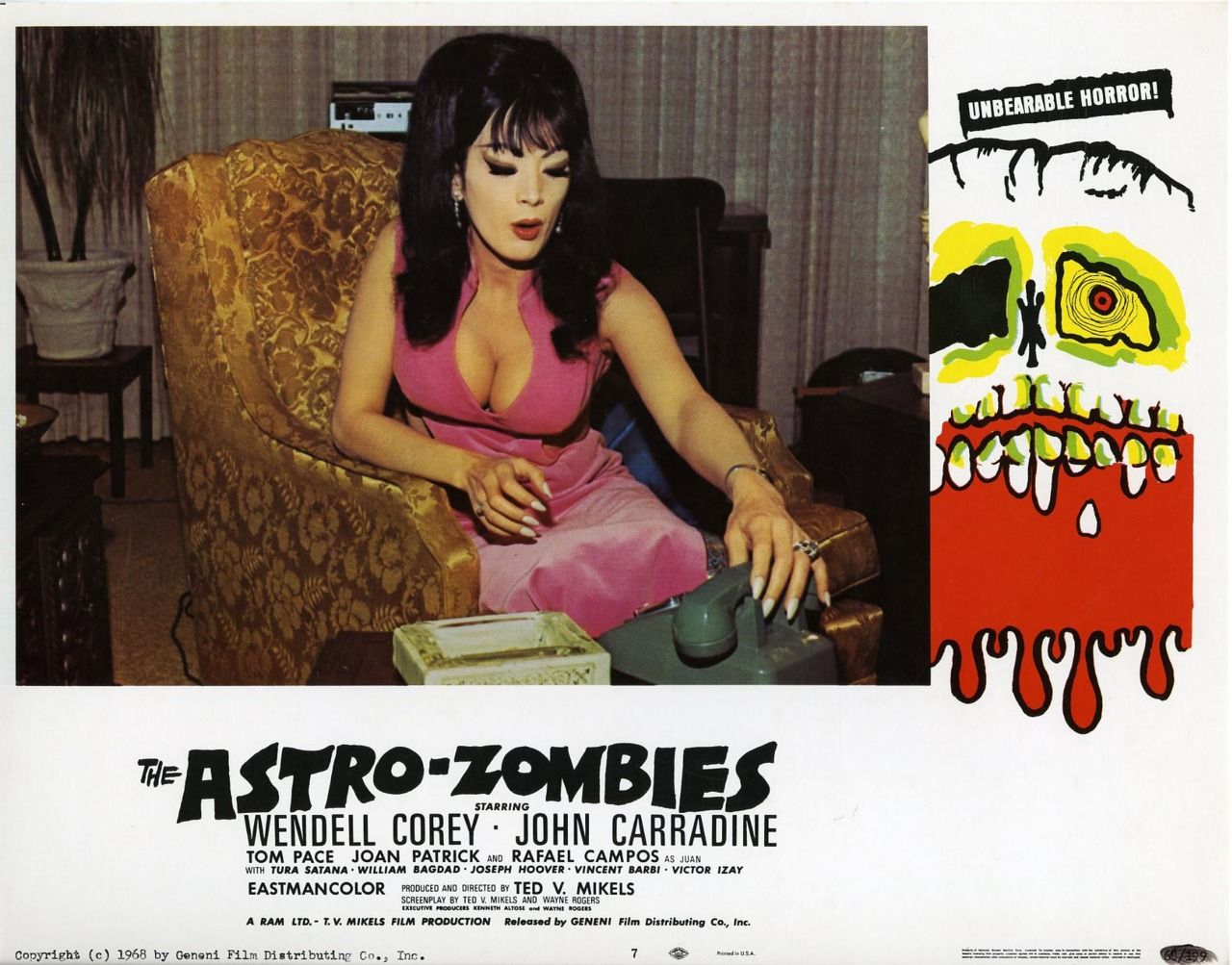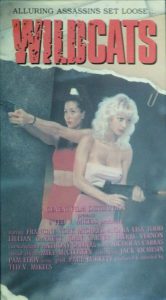 #FridayNightAtTheHomeDriveIn………………… .. ….. ….. ….. ….. ….. ….. ….. ….. ….. ….. ….. ….. The Astro-Zombies (1968) by #TedVMikels
#FridayNightAtTheHomeDriveIn………………… .. ….. ….. ….. ….. ….. ….. ….. ….. ….. ….. ….. ….. The Astro-Zombies (1968) by #TedVMikels
w/ #WendellCorey #JohnCarradine #TomPace #JoanPatrick #TuraSatana
“SEE Astro Space Lab”
“SEE Brutal Mutants Menace Beautiful Girls”
“SEE Crazed Corpse Stealers”
“SEE Berserk Human Transplants”
#Horror #SciFi
#NotQuiteClassicCinema
As I may have mentioned in a previous post about The Doll Squad (1973):
I first read about filmmaker Ted V. Mikels in a book called Incredibly Strange Films, published by RE/Search in 1986. I was writing a major paper for a film studies class and had chosen to do a semiotic analysis of Women In Prison films. A fellow student told me that there was a chapter on those movies in Incredibly Strange Films, so I went out and bought a copy at one of the better bookstores in town. There wasn’t a ton of information on Women In Prison films, but the book was fascinating and I read it from cover to cover.
There was a chapter about Ted V. Mikels, and he seemed like a fascinating guy. One of the films that appeared to be a centrepiece (or a cornerstone?) of his filmography was The Astro-Zombies (1968). In my quest to see all of the movies that the book talked about (including all of Ted V. Mikels films), The Astro-Zombies was one of the first that I was able to get a hold of at my favourite video store. I remember watching it, and thinking that it was one of the cheapest looking sci-fi horror films that I had ever seen.
Of course, I had seen The Creeping Terror (1964) as a child, so nothing could ever really equal THAT, but that’s another story…
I think I may have been slightly disappointed in The Astro-Zombies the first time that I watched it. The poster, and the pictures, had made it look like a crazy, over-the-top sci-fi horror experience – and I was pretty excited to find a copy on VHS. I also knew that Tura Satana was in it – and she was practically a legend for starring in Faster, Pussycat! Kill! Kill! (1965) (a film, that I might add, I had not seen yet either, and was very desperately wanting to, because Russ Meyer was another filmmaker featured in Incredibly Strange Films,). In short, I think my expectations might have been running a little high when I popped The Astro-Zombies into the VCR.
Those ancient B-movie nights are all a little bit hazy to me now, but I think I felt that the film suffered from a bit of a split personality. One the one hand, it had some pretty entertaining horror action: crazy, weird outer-space-man zombies that attacked and killed beautiful women for no apparent reason. On the other hand, it had some pretty long, dull scenes of pseudo-science, and jargon-laden dialogue meant to explain what the hell was going on (I think). Or maybe it was that it seemed like a 1960s soap opera of espionage-related weirdness, crossed with some horror sci-fi action – I can’t really remember. It felt a bit like two different movies fused together, and I wasn’t sure what I thought about it.
I do recall thinking that Tura Satana was superb as one of the villains, but that perhaps there wasn’t enough of her in this film. And as much as I could appreciate the legendary horror star John Carradine, there was too much of him doing science, and not enough of Tura Satana slapping people around. Still, she was worth the price of the rental alone.
Of course, as the years have gone by, and I have learned to appreciate stranger and stranger films, I can now look at a movie like The Astro-Zombies with completely different eyes. As I may have said, when discussing another Ted V. Mikels film called Mission Killfast: I have a very high tolerance – and in fact an appreciation – for movies that most people would dismiss as “bad”. I also see low budget independent films differently now, having been involved in the making of several of them over the years. The simple act of getting a film done and released is something that I now see as admirable in it’s own way. And if the film is watchable – or even pretty good – then it’s even more laudable.
Having said that, I happen to like Ted V. Mikels’ style of cinematic schlock, and I admire his ability to get things done. And I think he, himself, is a fascinating character and I love to listen to him talk about his movies (but perhaps I’m getting a bit off track). All of this is my way of leading up to saying that I enjoyed The Astro-Zombies much more last #FridayNightAtTheHomeDriveIn than I did all those years ago. Having seen a few movies that were originally two (or more) different films fused together, I can now say that The Astro-Zombies is much more coherent than that. And I actually enjoyed the long scenes of scientific nonsense, and the espionage story (which involves Tura Santana). It all worked for me in ways that my younger self might have never imagined.
And, of course, it’s never looked and sounded better than it does on the Kino Lorber Blu-ray, so that’s something to celebrate.
One weird fact to make note of: the film was co-written and executive-produced by Wayne Rogers, who most of us remember as Capt. ‘Trapper John’ McIntyre on M*A*S*H (1972-1975). Sadly, he does not play a role in this movie.
The Astro-Zombies (1968) is truly a classic of #NotQuiteClassicCinema. It may not be for everyone, but if you know what Ted V. Mikels’ films are like, then you already have a pretty good idea of whether nor not this film is for you. I will certainly look forward to enjoying it again on some future #FridayNightAtTheHomeDriveIn.
The Astro-Zombies (1968) by #TedVMikels
w/#WendellCorey #JohnCarradine #TuraSatana"SEE Astro Space Lab"
"SEE Brutal Mutants Menace Beautiful Girls"
"SEE Crazed Corpse Stealers"
"SEE Berserk Human Transplants"#Horror #SciFi#NotQuiteClassicCinema pic.twitter.com/cXO4VKGYwx— Angus Kohm (@AngusKohm) December 11, 2021



